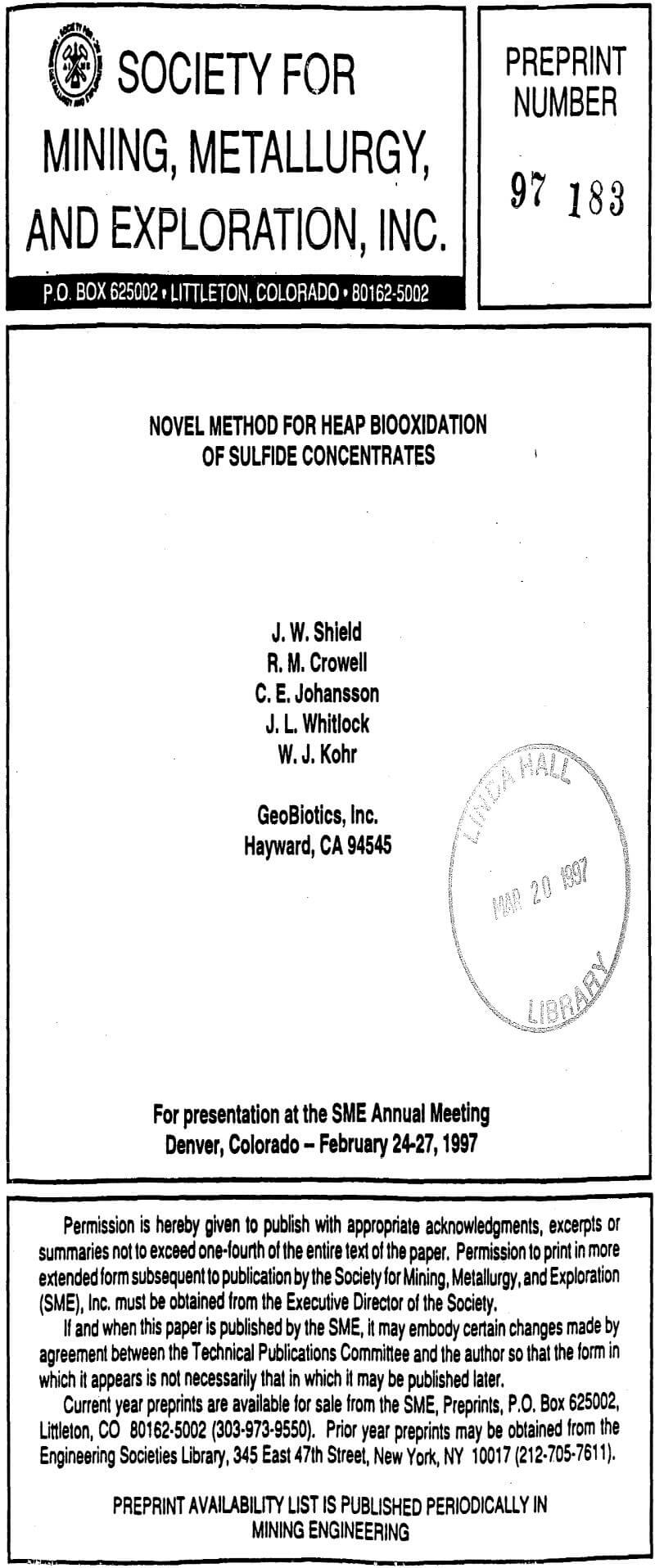Low-cost oxidation pretreatment technologies are needed in order to economically extract precious metals from refractory sulfidic deposits as the world’s free-milling reserves are consumed. Already, more than one-third of the gold ore reserves in the United States are considered to be refractory. Many of the deeper gold deposits that are currently being discovered, including deeper extensions of known oxide deposits, are refractory in nature due to sulfide encapsulation of the gold.
To meet this challenge, new biooxidation processes are being developed that use naturally occurring microorganisms that mitigate the refractory nature of sulfide ores. Biooxidation at near ambient pressures and temperatures reduces the capital and operating costs associated with alternative oxidation technologies.
GeoBiotics, Inc. had developed a proprietary approach to biooxidation that exhibits the high gold recoveries associated with conventional refractory ore oxidation processes and the low operating and capital costs associated with heap processes.
Geobiotics Heap Bio-oxidation of Sulfide Concentrates Process
Initially, a coarse support material is prepared by screening ore or waste rock. If ore is used, it can be either high or low grade material. Next, a thin layer of gold-bearing refractory sulfide concentrate is coated onto the sized rock. The coated support rocks are placed in a heap or vat, inoculated with iron and sulfur oxidizing microorganisms and allowed to biooxidize. After biooxidation, several processing options are available, but typically the coating is removed and gold is recovered via traditional cyanide leaching processes.
Figure 1 depicts a schematic of a coated support rock and biooxidation heap. The refractory sulfide layer is typically under 0.05 in. thick. Flotation and gravity concentrates have been tested successfully as sources of the gold-bearing sulfide coating. Some concentrates were first cyanide leached and then biooxidized. Typically the concentrate will originate from a conventional milling and flotation process, generally with a size distribution of 80% passing 200 mesh. The support material typically has a nominal diameter of 0.375 – 0.75 inches, and can be virtually any material that can withstand the low pH biooxidizing environment. Typical materials include barren rock and ore. The dry weight ratio of support to coated material is about 5 to 1.
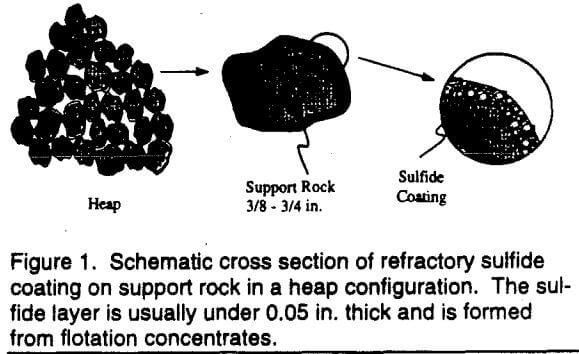
Figure 2 shows how this biooxidation technology can be integrated as a pretreatment step into a conventional gold mill flow sheet. Processing the refractory ore adds three processing steps: 1) the formation of a refractory concentrate, in this case by flotation, 2) coated biooxidation and 3) treatment of a dilute sulfuric acid stream. The coated biooxidation process is shown in greater detail in Figure 3. The sulfide gold concentrate is coated onto support rocks. The coated rocks are then stacked in a heap, inoculated with bacteria such as Thiobacillus ferrooxidans and biooxidized. After 30 to 90 days, the coated rocks are removed from the heap and the coating is stripped from the support. The stripped concentrate is then neutralized followed by a cyanide leach, and the support is recycled, processed or discarded.
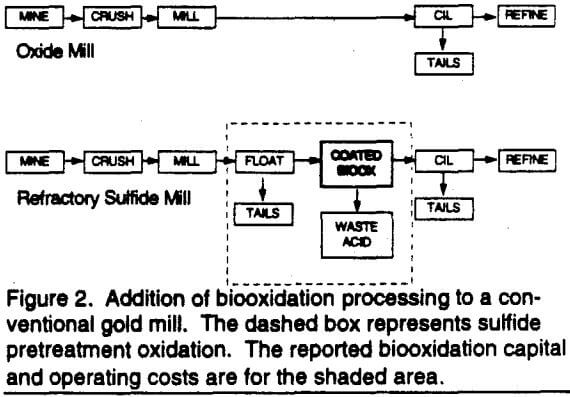
The capital equipment associated with the coated concentrate technology is typical of conventional heap leaching and consists primarily of a lined pad, conveyors,
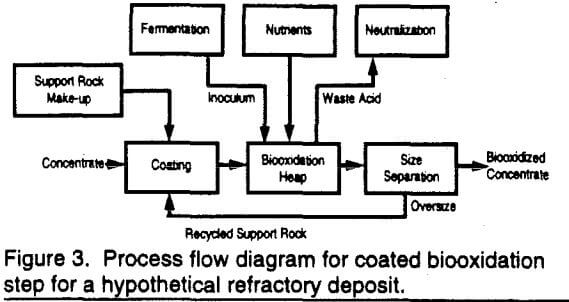
stackers and loaders. GeoBiotics commissioned Kvaerner Davy (San Ramon, CA) to conduct a prefeasibility study of the biooxidation portion of the process (denoted by the shaded area in Figure 2). Capital costs were estimated to ±30% and operating costs to ±20% for a hypothetical sulfide refractory gold deposit located in central Nevada. The sulfides were assumed to be pyritic and capable of forming a sulfide flotation concentrate at a 10:1 concentration ratio. Biooxidation was projected to occur over a 9 week cycle during which 50% of the sulfides were biooxidized.
Two different mill feed rates were examined. Table 1 summarizes the capital and operating costs for the biooxidation pretreatment step taken from the Kvaerner Davy study.
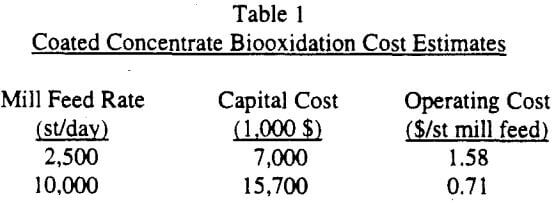
These costs are associated with the biooxidation pretreatment of the refractory ore, exclude neutralization, and assume that the treatment section is associated with an operating facility. To get a complete and site specific cost estimate, costs for mining, milling, flotation, cyanide leaching, gold recovery, tailings disposal, environmental, reclamation, and administrative functions need to be added.
The major component of the capital cost estimate involved the conveyors, stackers and reclaim equipment. The major component of the operating cost estimate was due to labor. The additional personnel for the 2,500 st/d and 10,000 st/d operation were 21 and 25 people respectively. Further details regarding the cost estimates are available.
Over 30 different refractory samples of cyanide leach tailings, flotation concentrates and gravity concentrates have been tested in 3 and 6 in. diameter and up to 12 ft. tall columns using this technology. Excellent biooxidation results have been obtained. Table 2 summarizes some of these results.
Concentrate biooxidation in a heap configuration is a viable and robust technology for a wide variety of gold bearing materials, including concentrates, and refractory tails from milling operations. Gold recoveries in excess of 80% and often over 90% coupled with the low capital and operating costs associated with heap processing, make this biooxidation technology a viable alternative when examining processing options for refractory sulfide gold deposits. This paper examines two additional key aspects of the coated technology in more detail:
- aeration within the heap, and
- formation and stripping of the coated particles.
Aeration
With the exception of ultra-fine grinding, all processes for pretreating refractory sulfide ores require the oxidation of the sulfide minerals to liberate the gold particles. Pressure oxidation, roasting and biooxidation involve the reaction of molecular oxygen with the sulfide minerals and encounter limitations in transferring sufficient oxygen during the reaction. Autoclaves and some roasting circuits typically include cryogenic oxygen generation plants to increase the partial pressure of oxygen in the reactor. Stirred tank biooxidation typically uses large high-pressure blowers and high shear conditions to produce sufficiently small air bubbles in order to maximize the oxygen mass transfer when aerating aqueous solutions. Transferring sufficient oxygen to the sulfides contributes a significant fraction of the capital and operating costs for these technologies.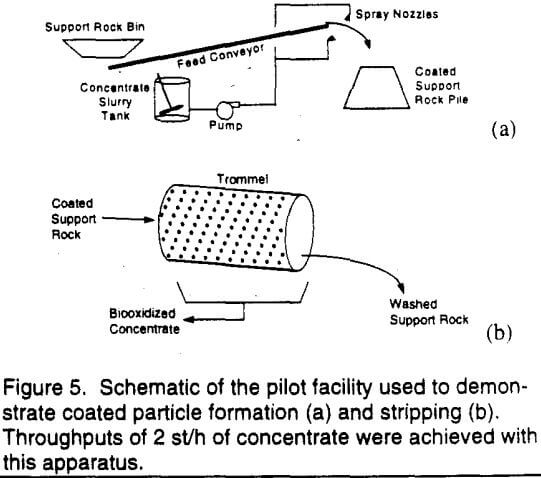
Biooxidation in a modified heap configuration has the potential to reduce these aeration costs. Unfortunately, with whole ore heap biooxidation, the wide size distribution of the ore and decrepitation that occurs during biooxidation leads to high pressure drops across the heap and channeling of air flows through the heap, making forced aeration ineffective or expensive These shortcomings can be overcome by controlling the size distribution of the ore before constructing the heap.
When a biooxidation heap is made with concentrate coated support rocks, the thin sulfide coating does not change the high porosity (large pore volume) found in a heap of narrowly sized material. Consequently, this heap configuration promotes excellent air flow characteristics enabling inexpensive aeration.
The volume of air required for biooxidation is determined by calculating the stoichiometric oxygen consumption due to sulfide oxidation. The chemical reaction for pyrite biooxidation is usually considered to be:
2 FeS2 + 7.5 O2 + H2O → Fe2 (SO4)3 + H2SO4………………………………………………(1)
So, the stoichiometric oxygen consumption is three and three quarter moles of molecular oxygen for every mole of pyrite.
The volumetric bulk density of concentrate in a heap has been measured. At a 5:1 support rock to concentrate weight ratio on sized support rock of a nominal 0.5 inch diameter, the density is 17 to 21 lb. of concentrate per cubic foot of heap. Most sulfide concentrates contain approximately 25 weight % sulfide sulfur, and often the extent of biooxidation required for efficient subsequent gold extraction is only 50%. At 35°C, this translates to 296 cubic feet of air required for every cubic foot of heap volume during the course of biooxidation. As biooxidation typically occurs over a period of 60 days, the average aeration rate required is 3.4 x 10 -3 cfm of air per cubic foot of heap. In laboratory column experiments, the biooxidation rate is not constant during the entire 60 days and often peaks about 20 days into a biooxidation experiment. The peak biooxidation rate is approximately 4 times the average biooxidation rate and the air distribution system should be designed accordingly. Thus for a 12 ft. tall heap the aeration flux rate (superficial velocity) should be 0.16 cfm/ft².
As the concentrate forms a uniform and thin coating onto the larger support rock, the aeration characteristics of the heap can be modeled by assuming that the heap is made up of uniform, irregular particles with a nominal diameter of the screened support rock. When the pressure drop is low and the particle Reynold’s number is less than 1, the Kozeny-Carman equation can be used to calculate the pressure drop through the heap.

Here, gc is the gravitational force unit, Dp the particle characteristic diameter, L the heap height, ε the bed porosity, µ the air viscosity at 35°C, V0 the superficial velocity, and ∅s the sphericity factor. The void fraction (porosity) within a heap made up of particles of this type and size has been measured and corrected for wall effects to 0.42. The sphericity factor for angular rocks is 0.75, and the particle characteristic diameter is 0.5 inch. The pressure drop across this heap is modeled to be 1.9 x 10 -4 in. of water per foot of heap height.
At these low superficial velocities the viscous drag forces predominate and the pressure drop will be proportional to the superficial velocity and inversely proportional to the square of the pore size. The pore size is approximately one half the diameter of the smallest independent particles in a packed bed.
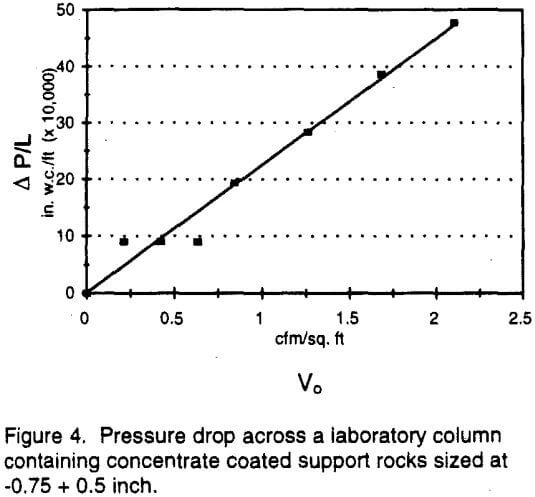
The particle Reynold’s number at these conditions is 0.6 and the pressure drop is low, validating the use of the Kozeny-Carman equation.
Pressure drop measurements were taken across a 7 ft. tall laboratory column and the results are shown in Figure 4. The expected linearity of pressure drop with superficial velocity is observed. Some difficulties were encountered in measuring the low pressure drops across the bed of coated particles at low air flow rates. When the bed porosity is high, equation 2 predicts pressure drops lower than those found experimentally, in this case by a factor of two and a half.
Oxygen content of the air exiting the laboratory column was measured during biooxidation and did not fall below 19.2%. This is not surprising in that the air flux in the laboratory column was operated at approximately 10 times that required by stoichiometry.
With a pore size between the coated concentrate particles of approximately 0.25 in.(one half the particle diameter), the pressure drop across the biooxidation heap is low. Aeration at these pressure drops and flow rates will be relatively inexpensive. For a 250 st/d concentrate operation and a 60 day biooxidation time, a pad of approximately 150,000 square foot would be needed and a low pressure blower of 24,000 cfm would be required. Such a blower equipped with a 50 HP motor can be purchased for under $12,000. Thus inexpensive blowers and distribution piping can be used to provide sufficient oxygen to the bacteria that oxidize the refractory sulfide minerals.